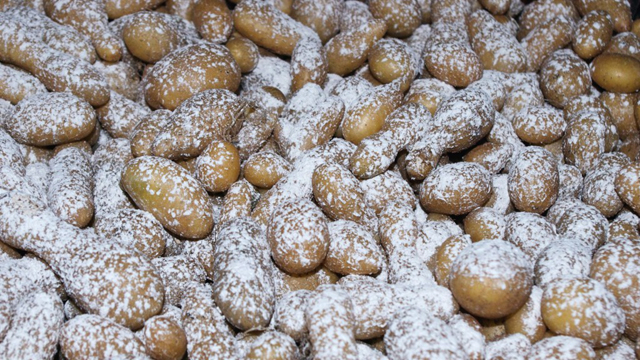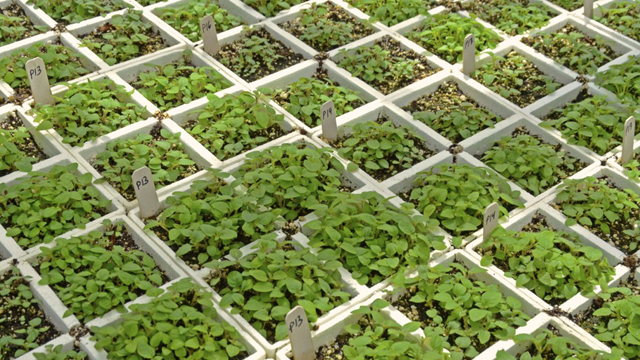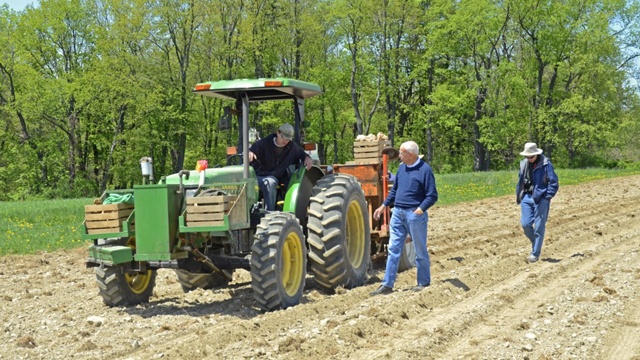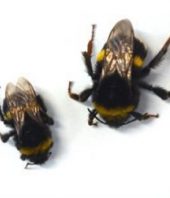Walter De Jong shouts over the roar of fans in the greenhouse. He’s telling me about the seedlings beside him, which pepper the dark soil in a grid of small planting pots. De Jong, a potato breeder and geneticist at Cornell University in Ithaca, New York, hopes that at least one of the plants will yield a best seller, but it’s far more likely that they’ll amount to compost.
De Jong produced the plants in the same old, laborious way that his father did before him. He collected pollen from a plant that produces potatoes that fry as potato chips should and then sprinkled the pollen on the flower of a potato plant that resists viruses. If the resulting potatoes bear their parents’ finest features—and none of the bad ones—De Jong will bury them in the ground next year and test their mettle against a common potato virus. If they survive—and are good for frying and eating—he and his team will repeat this for 13 years to ensure that problematic genes did not creep in during the initial cross.
Each year, the chance of failure is high. Potatoes that resist viruses, for example, often have genes that make them taste bitter. Others turn an unappetizing shade of brown when fried. If anything like that happens, De Jong will have to start from scratch. Tedious as it is, he loves the work. Kicking up dirt in the furrows that cascade along the hillsides of upstate New York, he says, “I’m never stressed in the potato fields.”
De Jong has some serious cred in the agriculture world. Not only was his father a potato breeder, he’s also descended from a long line of farmers. The potato farmers he works with appreciate this deeply, along with his commitment to the age-old craft of producing new potato varieties through selective breeding. They even advocated on his behalf during his hiring and when he was up for tenure at Cornell, a school with a long history of agriculture research. “All of our farmers like Walter,” says Melanie Wickham, the executive secretary of the Empire State Growers organization in Stanley, New York. Often, he’s in the fields in a big hat, she says. Other times “you’ll see him in the grocery store, looking over the potatoes.”
De Jong has been working with farmers long enough to know that our food supply is never more than a step ahead of devastating insect infestations and disease. Selective breeders like De Jong work hard to develop resistant crops, but farmers still have to turn to chemical pesticides, some of which are toxic to human health and the environment. De Jong enjoys dabbing pollen from plant-to-plant the old-fashioned way, but he knows that selective breeding can only do so much.
So while De Jong still devotes most of his time to honing his craft, he has recently begun to experiment in an entirely different way, with genetic engineering. To him, genetic engineering represents a far more exact way to produce new varieties, rather than simply scrambling the potato genome’s 39,000 genes the way traditional breeding does. By inserting a specific fungus-defeating gene into a tasty potato, for example, De Jong knows he could offer farmers a product that requires fewer pesticides.
“We want to make food production truly sustainable,” De Jong says, “and right now I cannot pretend that it is.”
The need to protect crops from ruin grows more vital every day. By 2050, farmers must produce 40% more food to feed an estimated 9 billion people on the planet. Either current yields will have to increase or farmland will expand farther into forests and jungles. In some cases, genetically modified organisms (GMOs) would offer an alternative way to boost yields without sacrificing more land or using more pesticides, De Jong says. But he fears this approach won’t blossom if the public rejects GMOs out of hand.
When It All Began
In the late 1990s, the agriculture corporation Monsanto began to sell corn engineered to include a protein from the bacteria Bacillus thuringiensis, better known as Bt. The bacteria wasn’t new to agriculture—organic farmers spray it on their crops to kill certain insects. Today more than 60% of the corn grown within the United States is Bt corn. Farmers have adopted it in droves because it saves them money that they would otherwise spend on insecticide and the fuel and labor needed to apply it. They also earn more money for an acre of Bt corn compared with a conventional variety because fewer kernels are damaged. Between 1996 and 2011, Bt corn reduced insecticide use in corn production by 45% worldwide(110 million pounds, or roughly the equivalent of 20,000 Olympic swimming pools).
Between 1996 and 2001, Monsanto also produced Bt potato plants. Farmers like Duane Grant of Grant 4D Farms in Rupert, Idaho, welcomed the new variety. Grant grew up on his family’s farm, and his distaste for insecticides started at a young age. As a teenager, he recalls feeling so nauseous and fatigued after spraying the fields that he could hardly move until the next day. Today, pesticides are safer than those used 40 years ago, and stiffer U.S. federal regulations require that employees take more precautionary measures when applying them, but Grant occasionally tells his workers to head home early when they feel dizzy after spraying the fields. He was relieved when GM potatoes were introduced because he didn’t have to spray them with insecticide. He was warned that pests might overcome the modification in 15 to 20 years, but that didn’t deter him—he says the same thing happens with chemicals, too.
Unlike Bt corn, you can’t find any fields planted today with Bt potatoes. Soon after the breed hit the market, protestors began to single out McDonald’s restaurants, which collectively are the biggest buyer of potatoes worldwide. In response, McDonald’s, Wendy’s, and Frito-Lay stopped purchasing GM potatoes. In 2001, Monsanto dropped the product and Grant returned to conventional potatoes and the handful of insecticides he sprays on them throughout the summer.
“There is not a single documented case of anyone being hurt by genetically modified food, and yet this is a bigger problem for people than pesticides, which we know have caused harm,” he says. “I just shake my head in bewilderment at the folks who take these stringent positions that biotech should be banned.”
In the decade after Monsanto pulled their GM potatoes from the market, dozens of long-term animal feeding studiesconcluded that various GM crops were as safe as traditional varieties. And statements from science policy bodies, such as those issued by the American Association for the Advancement of Science, the U.S. National Academy of Sciences, the World Health Organization, and the European Commission, uphold that conclusion. Secondly, techniques to tweak genomes have become remarkably precise. Specific genes can be switched off without lodging foreign material into a plant’s genome. Scientists don’t necessarily have to mix disparate organisms with one another, either. In cisgenic engineering, organisms are engineered by transferring genes between individuals that could breed naturally.
Even some organic farmers bristle when asked about the anti-GMO movement. Under the U.S. Organic Foods Production Act, they are not allowed to grow GMOs, despite their ability to reduce pesticide applications. Organic farmers still spray their crops, just with different chemicals, such as sulfur and copper. Amy Hepworth, an organic farmer at Hepworth Farms in Milton, New York, says that they, too, can take a toll on the environment.
Hepworth would like to continuously evaluate new avenues towards sustainable agriculture as technology advances. However, her views often clash with her customers’ in the affluent Brooklyn, New York, neighborhood of Park Slope. Many of them see no benefit in GMOs’ ability to reduce pesticides because they say farmers should rely strictly on traditional farming methods.
“What people don’t understand is that without pesticides there is not enough food for the masses,” Hepworth says. “The fact is that GM is a tool that can help us use less pesticide.”
A Chemical World
Back when Monsanto introduced its GM potatoes, De Jong did not argue with people who opposed them. Although the potatoes seemed practical, he felt that Monsanto was powerful enough to defend itself. Indeed, he frequently voices his distaste how the company has used its monopoly over agriculture worldwide. (De Jong is not affiliated with Monsanto.) However, Monsanto’s association with GMOs—the company sells many such seed lines—means public opinion against it has morphed into a hatred of GMOs in general. Myths about the health dangers of GMOs abound, which upsets De Jong as a scientist.
But what really catalyzed De Jong’s concerns over misguided fears of GMOs was a recent trip he took to Indonesia. As De Jong’s van rumbled through the countryside late last April, he watched men in T-shirts and no facemasks spraying chemicals on their crops. While touring a potato farm, he snapped a photograph of insecticide powder blanketing crates of stored potatoes like snow. Insects thrive in Indonesia’s tropical climate, and farmers spray certain crops heavily to prevent damage. The chemicals they use tend to be more toxic because newer, safer chemicals cost more. Plus, chemical regulations that are common in U.S. and Europe are rarely enforced in the developing world. “I just felt awful because some of this is really nasty stuff,” De Jong says. “We can pretend that this doesn’t happen, but it does.”
It’s not just a problem in Indonesia, either. In parts of India, farmers spray more than 60 insecticides on their eggplant—known to locals as brinjal—during the growing season, mainly to protect the purple fruit from burrowing bugs, says Ponnuswami Balasubramanian, a plant molecular biologist at Tamil Nadu Agricultural University in Coimbatore, India. To reduce the insecticide load without losing the harvest, Balasubramanian, together with public sector researchers and a private Indian seed company, developed Bt versions of four varieties of eggplant that are popular in southern states. Monsanto was not involved, but still public outcry from GMO opponents blocked the eggplants from federal approval.
“It was madness to stop Bt brinjal” says Kulvinder Gill, an agricultural geneticist at Washington State University in Pullman, Washington, who grew up in India and was not involved with the project. “People should not even be eating this brinjal because it has so much insecticide on it,” Gill says, “Anything to reduce that would be extremely beneficial.”
A continent away, Nigerian farmers who rely on crop rotation and other traditional farming techniques lose up to 30% of their crops of cowpeas, cabbage, and pumpkin leaves to pests, says Sylvia Uzochukwu, a food microbiologist at the University of Agriculture in Abeokuta, Nigeria. As a result, she says many farmers spray their fields heavily during the growing season. Uzochukwu has been talking with farmers and the public about the introduction of GM crops as a way to help the country’s economy, reduce pesticides, and improve health.
The City and the Country
I first encountered De Jong on April 4, when he sat on a panel about GMOs in New York City hosted by the advocacy groups GMO Free NY and the Wagner Food Policy Alliance. The modest awkwardness that endears him to farmers didn’t charm the audience. As De Jong explained how scientists create GMOs, they began to murmur, lost amidst De Jong’s scientific jargon and meandering delivery.
De Jong did, however, liven up during a discussion in which Jean Halloran, a member of the panel from the Consumer’s Union, suggested that farmers in the developing world could ditch pesticides, not use GMOs, and increase yields. “We favor a knowledge-based approach rather than a chemical-based approach to increasing production,” Halloran had said.
De Jong did not find this solution realistic and asked, “Do you want to be the African farmer who has to apply insecticide every week—really nasty stuff—without protective equipment?” The question hung in the air for a second, and the panelist beside him repeated the no-chemical mantra.
Weeks later, De Jong tells me the panel opened his eyes. He was shocked at how people who don’t live near farms feel entitled to advise farmers, especially on environmental matters. “There is a romantic notion of environmentalism, and then there is actual environmentalism,” De Jong says. “Farmers are very conscious of the environment. They want to hand off their operation to their kids and their kids’ kids, so they maintain the land the best they can while doing what they need to do in order to sell their harvest,” he says. “My guess is that the majority of people who are anti-GM live in cities and have no idea what stewardship of the land entails.”
“I find it so tragic that, by and large, crop biotechnologists and farmers want to reduce their pesticide use, and yet the method we think is most sustainable and environmentally friendly has been dismissed out of hand.” He pauses as he recalls the event and says, “There is no scientific justification for it—it is just as if there is a high priest who decided, ‘Thou shalt not be GMO.’ ”
Into An Uncertain Future
Despite the anti-GMO movement and the hesitation of many governments to approve of new GM crops, biotechnology moves forward. During his recent trip to Indonesia, De Jong volunteered to help public sector scientists create a GM potato that resists potato blight, the disease responsible for the Irish potato famine that killed more than a million people in the mid-1800s. De Jong hopes to endow the potato with several modifications that won’t be easily overcome by the fungus-like organism that causes blight, Phytophthora infestans.
The project has an uncertain future, though, one that has less to do with science and more to do with politics. “I worry that when the Indonesian government nears its approval, Greenpeace will invade with a lot of money and a lot of PR stunts,” De Jong says. “The question is, what happens then?” (Greenpeace was contacted for comment, but offered no comment prior to publication.)
Some scientists hope to abate the public’s fears of “Frankenfoods” with cisgenic engineering, in which the inserted genes belong to the same type of organism. Anton Haverkort, an agroecologist at Wageningen University and Research Centre in the Netherlands, is banking on that idea. Every year, 99% of potato farmers in the Netherlands spray fungicides to combat blight at a cost of 110 million euros, Haverkort says. To reduce chemical use, he is leading an effort to make a cisgenic blight-resistant potato, which is supported by the Dutch government, despite the cool reception GMOs receive in Europe.
In the U.S., a potato engineered for a different purpose entered into one of the last stages of the approval process in March. Its developer, food company J.R. Simplot, calls it the “innate potato” because it carries no foreign genes. Instead, its genome is manipulated so that a protein that causes browning fails to activate and a cancer-causing chemical, acrylamide, which can form naturally when potatoes are cooked at high temperatures, does not accumulate.
However, De Jong doubts that cisgenic or innate potatoes will defuse GM opponents. “I suspect that they will still see it as tinkering,” he says. To him, a more important question for these other approaches would be whether such potatoes remain effective over time. In the case of blight-resistance, the best potato is the one that the pathogen cannot gradually overcome.
Evidence-based studies can determine the answer to that question, and these are just the sort of questions that De Jong would like to ask. Rather than protest every GMO, De Jong wishes society would confront various aspects of genetic engineering—some of which trouble him, including laws on how modifications are patented and priced and the inconsistent way in which regulatory agencies assess GMOs.
At the moment, only large corporations have the financial resources to weather the approval process, which, by and large, isn’t standardized and can drag on for several years. Multiple US federal agencies, driven in part by the public’s fears, ask for proof on safety and efficacy beyond a point that feels reasonable to some scientists. For example, people worry that inserted genes will spread to wild crops, but reported occurrences have been exceedingly rare and their existence is debated among the scientific community. As agencies examine and re-examine all imaginable scenarios, public sector projects and small businesses crumble under the pressure of paying employees while taking in no revenue.
“Some of the regulations required for crop approval are not science-based, and they have crippled the ability of the public sector to deploy GMOs for public benefit,” De Jong says, “I can make a transgenic potato for less than $50,000, but I cannot afford to pay five to ten million dollars to go through regulatory hoops.” As a result of hurdles like these, Monsanto’s engineered corn and soybeans monopolize the market for GMOs. By enforcing their patents on GM seeds, Monsanto and other large corporations with GMO products can dictate how much farmers pay for seeds—a precarious dependency to be in when an additional 2 billion people in developing nations need to be fed in 2050. De Jong is pushing for policy reform.
De Jong’s vow to speak his mind on GMOs could be futile, at least for now. It takes potato breeders decades to see one of their varieties succeed on the market, and De Jong says he would not be surprised if it takes longer than his lifetime for the public to accept genetic modification. But for people who spend years watching plants grow, patience is a virtue. For De Jong, those roots extend far back in his family tree. He is descended from a long line of Mennonites, a denomination of Christians renowned for their ability to farm even the poorest soil.
De Jong recalls a lesson from his past, when at 15 he asked his father why farmers did not buy a pretty potato variety with pale skin and yellow flesh. His father replied that consumers didn’t want it. But a few years later, just such a potato hit it big—the Yukon Gold. “This taught me that if I think a potato is interesting, and others aren’t hot on it, I should just trust my gut.” Eventually, the rest of the world might catch on.
Source: NOVA
Read more: http://www.pbs.org/wgbh/nova/next/nature/fewer-pesticides-farming-with-gmos/








